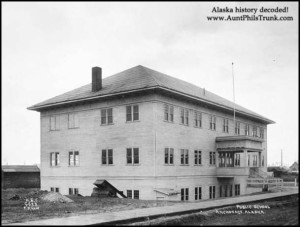School Days Delayed in Early Anchorage

This school building, constructed by the U.S. government, was paid for by using 50 percent of the funds raised by selling lots in Anchorage during 1915. Congress authorized its construction on April 17, 1917.
When Land Office chief Andrew Christensen opened the auction for the townsite above Ship Creek on July 10, 1915, bidding became so brisk that prospective lot owners couldn’t hold down prices. After sales closed a week later, 655 lots had sold for almost $150,000 (more than $3.5 million in today’s dollars). Christensen claimed the sale had “injected confidence in the people of the town.”
But that confidence may have been tempered somewhat when the residents realized the Alaska Engineering Commission had overlooked a vital component in the new town. The Commission had sold the parcels of land with the understanding that the lots could be assessed to finance such public services as water and sewer utilities, fire protection and garbage pickup, but it had neglected to provide for financing a school.
It took months to solve the dilemma. In summer 1915, the editor of the Cook Inlet Pioneer wrote: “If we are to retain the families, and they compose the backbone of any community, we must provide the children with adequate school facilities. It is highly important that this should be done without undue delay. …”
The federal government finally solved the predicament in late September after commissioners William C. Edes and Frederick Mears convinced the Comptroller General to issue funds for construction of a school house.
Completed in November 1915, Anchorage’s first school was built to serve about 90 students. From the beginning, residents labeled the school “entirely inadequate,” “unsanitary,” and “of an order of the early eighteenth century.” The school lacked a solid foundation, paint and a satisfactory heating system, and its unheated outdoor toilets didn’t meet townsite standards.
Edes ordered Andrew Christensen to take over the responsibility of “school director in addition to your other duties,” in 1917. Although school board members A.J. Wendler, Mrs. W.T. Normile and M. Finkelstein had handled the first year of operation admirably, enrollment had doubled to more than 200 pupils by the fall of 1917. The school also had management problems. One teacher taught 70 primary students in half-day shifts.
Christensen told the principal he “must quit going to the pool halls and must get down to business,” and he advised one teacher “to stop gossiping, complaining and criticizing, and to bring her work up to standard.”
That one-room school house was used only for overflow after a second school, finished in December 1917, opened on the School Reserve. The three-story structure (pictured above), known as Pioneer School, had all the modern conveniences. Soon it was maintained day and night, with seven teachers and 300 schoolchildren attending classes by day and 10 teachers and about 200 students in the building in the evenings, according to information on the photograph.
It served both elementary and high school students until the mid-1930s.
Pioneer School now sits at Third Avenue between Eagle and Denali streets and is used as a public meeting place.
The post School Days Delayed in Early Anchorage appeared first on Aunt Phil's Trunk.



